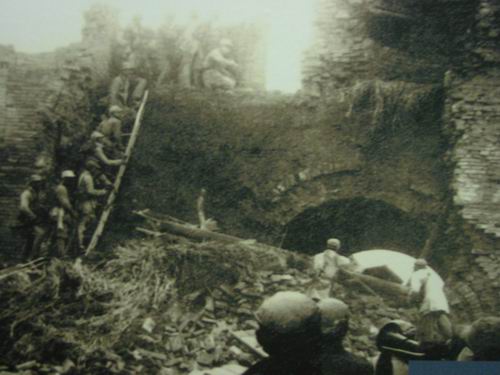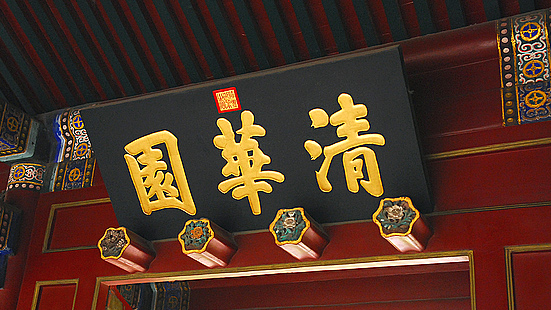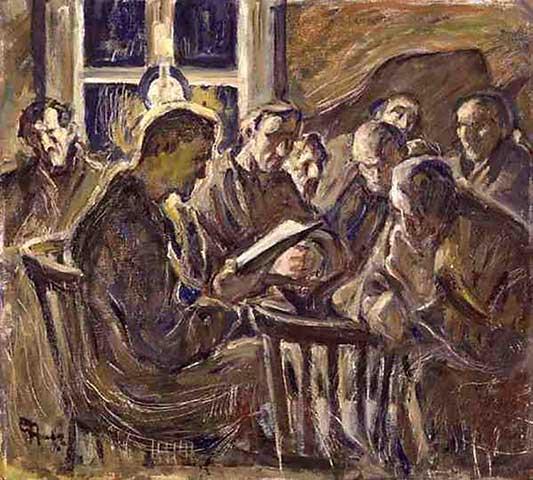|
December 9th Movement
The December 9th Movement () was a mass protest led by students in Beiping (present-day Beijing) on December 9, 1935, to demand that the Chinese government actively resist Japanese aggression. Background After the Japanese Imperial Force occupied Manchuria following the Mukden Incident in 1931, it attempted to follow up with an invasion into northern China. Between June and July 1935, the Chin-Doihara Agreement was negotiated between Japan and the Chinese Kuomintang (KMT) government as a way for the former to gain control of Chahar Province. A puppet state known as " Eastern Hebei Anti-Communist Autonomous Government" was then set up by a Yin Rugeng with Japanese help. In response to the demands by Japan to create a separate regime in Northern China, the KMT government was forced to establish the " Hebei-Chahar Political Council". The Chinese Communists, on the other hand, called for a voluntary mobilization of all Chinese people to resist Japanese aggression in a proclamat ... [...More Info...] [...Related Items...] OR: [Wikipedia] [Google] [Baidu] |
Chinese Civil War
The Chinese Civil War was fought between the Kuomintang-led Nationalist government, government of the Republic of China (1912–1949), Republic of China and the forces of the Chinese Communist Party (CCP). Armed conflict continued intermittently from 1 August 1927 until Communist victory resulted in their total control over mainland China on 7 December 1949. The war is generally divided into two phases with an interlude: from August 1927 to 1937, the First United Front alliance of the KMT and CCP collapsed during the Northern Expedition, and the Nationalists controlled most of China. From 1937 to 1945, hostilities were mostly put on hold as the Second United Front fought the Second Sino-Japanese War, Japanese invasion of China with eventual help from the Allies of World War II. However, armed clashes between the groups remained common. Exacerbating the divisions within China further was the formation of the Wang Jingwei regime, a Japan-sponsored puppet government led by Wang ... [...More Info...] [...Related Items...] OR: [Wikipedia] [Google] [Baidu] |
Gansu
Gansu is a provinces of China, province in Northwestern China. Its capital and largest city is Lanzhou, in the southeastern part of the province. The seventh-largest administrative district by area at , Gansu lies between the Tibetan Plateau, Tibetan and Loess Plateau, Loess plateaus and borders Mongolia's Govi-Altai Province, Inner Mongolia and Ningxia to the north, Xinjiang and Qinghai to the west, Sichuan to the south and Shaanxi to the east. The Yellow River passes through the southern part of the province. Part of Gansu's territory is located in the Gobi Desert. The Qilian Mountains, Qilian mountains are located in the south of the Province. Gansu has a population of 26 million, ranking List of Chinese administrative divisions by population, 22nd in China. Its population is mostly Han Chinese, Han, along with Hui people, Hui, Dongxiangs, Dongxiang and Tibetan people, Tibetan minorities. The most common language is Mandarin. Gansu is among the poorest administrative divi ... [...More Info...] [...Related Items...] OR: [Wikipedia] [Google] [Baidu] |
Shaanxi
Shaanxi is a Provinces of China, province in north Northwestern China. It borders the province-level divisions of Inner Mongolia to the north; Shanxi and Henan to the east; Hubei, Chongqing, and Sichuan to the south; and Gansu and Ningxia to the west. Shaanxi covers an area of over with about 37 million people, the 16th-largest in China. Xi'anwhich includes the sites of the former capitals Fenghao and Chang'anis the provincial capital and largest city in Northwest China and also one of the oldest cities in China and the oldest of the Historical capitals of China, Four Ancient Capitals, being the capital for the Western Zhou, Western Han, Sima Jin, Jin, Sui dynasty, Sui and Tang dynasty, Tang List of Chinese dynasties, dynasties. Xianyang, which served as the capital of the Qin dynasty (221–206 BC), is just north across the Wei River. The other Prefectures of China, prefecture-level prefecture-level city, cities into which the province is divided are Ankang, Baoji, Hanzho ... [...More Info...] [...Related Items...] OR: [Wikipedia] [Google] [Baidu] |
Chang'an Avenue
file:50th anniversary of PRC 1.jpg, 250px, Chang'an Avenue hosts military parades. Here are armoured fighting vehicles leaving Tian'anmen Square during the 50th anniversary of the People's Republic of China, 1999 National Day parade. Chang'an Avenue (), literally "Eternal Peace Street", is a major road, thoroughfare in Beijing, China. Chang'an () is also the old name for Xi'an which was the capital of China during the Han dynasty, Western Han dynasty, the Tang dynasty and other periods. The Avenue has also been referred to as the Shili Changjie (), meaning the Ten Li (unit), Li Long Street, China's No. 1 Avenue and No. 1 Avenue of the Divine Land. "Chang'an Avenue" is often used as a synecdoche for the government in Beijing, akin to using "the Beltway" to refer to the American federal government. Chang'an Avenue starts from Dongdan, Beijing, Dongdan in the east and ends at Xidan in the west. Tiananmen and Tiananmen Square are located at the north and south of the center of th ... [...More Info...] [...Related Items...] OR: [Wikipedia] [Google] [Baidu] |
Yenching University
Yenching University () was a Private university, private research university in Beijing, China, from 1919 to 1952. The university was formed out of the merger of four Christian colleges between the years 1915 and 1920. The term "Yenching" comes from an alternative name for old Beijing, derived from its status as capital of Yan (state), the state of Yan, one of the seven Warring States that existed until the 3rd century BC. History Yenching University was formed through the merger of four Christian schools over the course of five years, from 1915 to 1920: * Hweiwen University (), also known as the Methodist Peking University, founded in 1890 by the Methodist Episcopal Church. This should not be confused with the Peking University, National Peking University founded eight years later in 1898. Huiwen's precursor (崇內懷理書院) was founded in 1870. Hiram Harrison Lowry was its principal. * North China Union College in Tongzhou District, Beijing, Tongzhou (). Its precursor (� ... [...More Info...] [...Related Items...] OR: [Wikipedia] [Google] [Baidu] |
Tsinghua University
Tsinghua University (THU) is a public university in Haidian, Beijing, China. It is affiliated with and funded by the Ministry of Education of China. The university is part of Project 211, Project 985, and the Double First-Class Construction. It is also a member in the C9 League. Tsinghua University's campus is in northwest Beijing, on the site of the former imperial gardens of the Qing dynasty. The university has 21 schools and 59 departments, with faculties in science, engineering, humanities, law, medicine, history, philosophy, economics, management, education, and art. History Early 20th century (1911–1949) Tsinghua University was established in Beijing during a tumultuous period of national upheaval and conflicts with foreign powers which culminated in the Boxer Rebellion, an uprising against foreign influence in China. After the suppression of the revolt by a foreign alliance including the United States, the ruling Qing dynasty was required to pay inde ... [...More Info...] [...Related Items...] OR: [Wikipedia] [Google] [Baidu] |
Arbitrary Arrest And Detention
Arbitrary arrest and detention is the arrest and detention of an individual in a case in which there is no likelihood or evidence that they committed a crime against legal statute, or in which there has been no proper due process of law or order. Arbitrary arrest and detention is similar to but legally distinct from wrongful detention, which is broader in scope and does not involve arrest. Background Virtually all individuals who are arbitrarily arrested are given no explanation as to why they are being arrested, and they are not shown any arrest warrant. Depending on the social context, many or the vast majority of arbitrarily arrested individuals may be held incommunicado and their whereabouts can be concealed from their family, associates, the public population and open trial courts. International law Arbitrarily depriving an individual of their liberty is prohibited under international human rights law. Article 9 of the 1948 Universal Declaration of Human Rights decrees th ... [...More Info...] [...Related Items...] OR: [Wikipedia] [Google] [Baidu] |
Freedom Of Assembly
Freedom of assembly, sometimes used interchangeably with the freedom of association, is the individual right or ability of individuals to peaceably assemble and collectively express, promote, pursue, and defend their ideas. The right to freedom of assembly is recognized as a human right, a Political freedom, political right and a Civil liberties, civil liberty. The terms ''freedom of assembly'' and ''freedom of association'' may be used to distinguish between the freedom to assemble in public places and the freedom to join an association. Freedom of assembly is often used in the context of the right to protest, while freedom of association is used in the context of labor rights. The Constitution of the United States is interpreted to mean both the freedom to assemble and the freedom to join an association. Human rights instruments Freedom of assembly is included in, among others, the following human rights instruments: * Universal Declaration of Human Rights – Article 20 * ... [...More Info...] [...Related Items...] OR: [Wikipedia] [Google] [Baidu] |
Freedom Of Press
Freedom of the press or freedom of the media is the fundamental principle that communication and expression through various media, including printed and electronic media, especially published materials, should be considered a right to be exercised freely. Such freedom implies the absence of interference from an overreaching state; its preservation may be sought through a constitution or other legal protection and security. It is in opposition to paid press, where communities, police organizations, and governments are paid for their copyrights. Without respect to governmental information, any government may distinguish which materials are public or protected from disclosure to the public. State materials are protected due to either one of two reasons: the classification of information as sensitive, classified, or secret, or the relevance of the information to protecting the national interest. Many governments are also subject to " sunshine laws" or freedom of information legis ... [...More Info...] [...Related Items...] OR: [Wikipedia] [Google] [Baidu] |
Freedom Of Speech
Freedom of speech is a principle that supports the freedom of an individual or a community to articulate their opinions and ideas without fear of retaliation, censorship, or legal sanction. The rights, right to freedom of expression has been recognised as a Human rights, human right in the Universal Declaration of Human Rights and international human rights law. Many countries have constitutional law that protects free speech. Terms like ''free speech'', ''freedom of speech,'' and ''freedom of expression'' are used interchangeably in political discourse. However, in a legal sense, the freedom of expression includes any activity of seeking, receiving, and imparting information or ideas, regardless of the medium used. Article 19 of the UDHR states that "everyone shall have the right to hold opinions without interference" and "everyone shall have the right to freedom of expression; this right shall include freedom to seek, receive, and impart information and ideas of all kinds, re ... [...More Info...] [...Related Items...] OR: [Wikipedia] [Google] [Baidu] |
He Yingqin
He Yingqin (; April 2, 1890 – October 21, 1987) also Ho Ying-chin, was a Chinese politician and one of the most senior generals of the Kuomintang (KMT) during Nationalist China, and a close ally of Chiang Kai-shek. Early years A native of Guizhou, He was healthy and bookish in his childhood. In 1907, he was enrolled in the Guiyang Military Elementary School, and transferred to the more famous Wuchang Third Army Middle School in the following year. In the same year, He was chosen by the Defense Department of Qing Dynasty to study in Japan in the 11th class of Tokyo Shimbu Gakko; a military preparatory academy. When studying in Japan, he became acquainted with fellow student Chiang Kai-shek. He learned military skills and was influenced by the anti-Qing Dynasty theories of the Tongmenghui, which he soon joined. In 1911 after the outbreak of Wuchang Uprising, He came back to China with other members of Tongmenghui to work for Chen Qimei, who was governor of Shanghai, and a ... [...More Info...] [...Related Items...] OR: [Wikipedia] [Google] [Baidu] |







